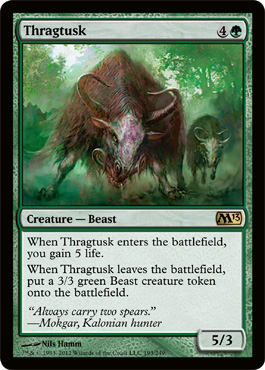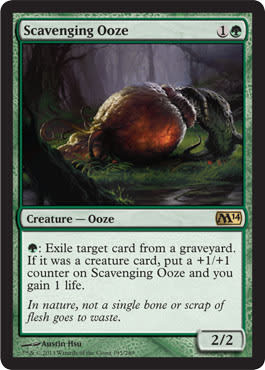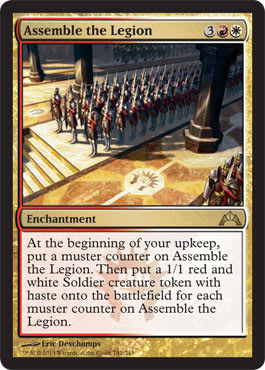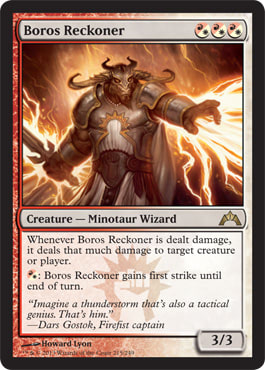This is possibly my least favorite time of the year, and it has nothing to do with my air conditioning breaking last weekend, the $6,000 my bank being “misplaced,” my laptop breaking, or this hangnail.
Hey, it’s been a rough week.
But no, this is my least favorite time of the year because it’s when Standard hits the doldrums. Any initial exploration of the core set has happened (Primeval Bounty, anyone?), and there’s a general sense that attempting to build anything new is pointless because the format is well-explored and rotates soon.
Theros really can’t get here soon enough.
In fact, I’ve already started looking ahead. I was fortunate to cover Pro Tour Dragon’s Maze and saw a glimpse of the future vis-a-vis Block Constructed. And let me say, the future looks glorious.
Now, there’s not much of a point in looking at how decks will adapt post-rotation because we don’t know what Theros will bring. The new fall set always ends up mattering more than people usually admit (plus the core set), meaning Standard actually rarely comes to resemble Block as much as people posit. I mean, everyone remembers Wolfir Silverheart and Entreat the Angels, right?
But what the rotation does do is clear out a whole host of cards that have oppressive or bolstering effects on other cards that aren’t rotating. To get a jump on the new format and fashion the lens through which we view Theros, it’s useful to look at the remaining cards that win and lose in the rotation.
So, let’s look at the Top 10 winners and losers in the rotation. Because people like Top 10 lists.
But first: some context. Here are the most important cards we’re losing in the rotation:
- Augur of Bolas
- Cavern of Souls
- Champion of the Parish
- Core/Innistrad Duals
- Falkenrath Aristocrat
- Gavony Township
- Geist of Saint Traft
- Hellrider
- Lingering Souls
- Moorland Haunt
- Nephalia Drownyard
- Restoration Angel
- Snapcaster Mage
- Sorin, Lord of Innistrad
- Thundermaw Hellkite
- Unburial Rites
Hmmm . . . that list seems to be missing a few cards. Oh yeah . . .
Jund
- Bonfire of the Damned
- Farseek
- Garruk, Primal Hunter
- Huntmaster of the Fells
- Kessig Wolf Run
- Liliana of the Veil
- Olivia Voldaren
- Thragtusk
Ding-dong, Jund is dead!—until next time Jund is a thing anyway.
There are a whole host of other relevant cards we’ll miss but that aren’t exactly pillars of the format or won’t be as necessary post-rotation. Pillar of Flame is less important when undying and Zombies rotate out (though Voice of Resurgence remains), and the same can be said of Terminus for the same reason. Blood Artist is a blow to The Aristocrats–style decks, but Lingering Souls and Champion of the Parish were the driving forces there anyway. Delver of Secrets hasn’t been a thing in Standard since Ponder and Mana Leak left. Invisible Stalker was always Robin to Geist of Saint Traft’s Batman. Unsummon only saw play with Snapcaster Mage—and so on, and so on, and so on.
So, given all of that, let’s start with the cards that are hurt the most in the rotation, barring something in Theros.
Top 10 Rotation Losers
10. Scavenging Ooze – Scavenging Ooze is a very powerful card and will probably continue to see play. It’s a solid value card that does much more than its 2-mana casting cost implies. That said, right now it serves as a way to keep graveyard strategies in check, to remove the “un” from undying, to make Snapcaster Mage’s life (and, subsequently, my life) hell, and to generally punish anyone who likes to play with his or her hand (graveyard) face-up. With Innistrad’s graveyard theme rotating, the Ooze will still be a strong card, but it won’t shape the metagame as it does now.
9. Rest in Peace – Does this even do anything anymore? Does the rules text rotate with Innistrad? This won’t be doing much of anything any time soon unless someone cracks Obzedat's Aid—someone other than Travis Woo. R.I.P., Rest in Peace. If this weren’t a sideboard card, it would be higher on the list.
8. Burning Earth – This one is somewhat tentative. It really depends on Theros’s mana-fixing. But it seems likely that, without the core and Innistrad duals, three-colored decks will become less the absolute norm and more a thing that pops up now and then. If two-colored decks become the rule rather than the exception, this will see a significant dip in play.
7. Clone – Clone was almost exclusively a way to fight Thragtusk and Angel of Serenity. The first is rotating, the latter is a lot less impressive without Cavern of Souls and Unburial Rites by its side. Throw in the new legend rule, and there’s virtually no reason to play a card that was somewhat niche to begin with.
6. Assemble the Legion – When covering Pro Tour Dragon’s Maze, I did an article on the format’s premier finishers for control decks. One such card was Assemble the Legion, which currently sees a bit of play in R/W/U as a hard-to-kill finisher/defensive card. In fact, I think people should be playing more Assemble the Legion right now in control decks.
The problem? As Martin Juza pointed out, Jace, Architect of Thought was everywhere at the Pro Tour, and chances are not bad that that could be the case post-rotation as well. If it is, Assemble won’t be a reliable finisher.
5. Turn // Burn – It’s possible that this should be lower on the list, and it’s even more possible that Theros will bring us new targets for this, but outside of Angel of Serenity, Return to Ravnica block wasn’t nearly as packed full of targets for this as the core set and Innistrad. If we don’t pick up a Pillar of Flame or Searing Spear replacement in Theros (unlikely), this will serve as the default control burn spell, but without Thragtusks to hunt, this spell starts to look too expensive.
4. Angel of Serenity – Never again will I have to stare in horror as my opponent uses Cavern of Souls to cast Angel of Serenity, tucking Restoration Angel, Thragtusk, and Huntmaster of the Fells safely underneath. And never again will someone lose to a turn-three or turn-four Angel off Unburial Rites. The card is still playable (it saw action in Block), but resolving a 7-mana creature is difficult in a world with no Cavern of Souls and a plethora of Essence Scatters seems rough.
3. Shadowborn Demon – How can this new card already be a loser? Especially when it’s so freakin’ awesome?
I’m not sold that this isn’t a huge sleeper, and it’s possible something in Theros will kick-start it, but two things will keep it down now. One, there’ll be no Lingering Souls to feed it. Two, Scavenging Ooze almost assures the six-creature clause will be even harder to fulfill than before. I love the Demon, but . . . but it seemed, appropriately enough, to be a creature better suited for Innistrad.
2. Cartel Aristocrat/Varolz, the Scar-Striped – Speaking of creatures better suited for Innistrad, Cartel Aristocrat always struck me as a leftover from that block that somehow made it to Ravnica. Varolz saw play in Brian Kibler’s Block deck, and it was good to boot, so there’s some hope. But without Lingering Souls, Blood Artist, Skirsdag High Priest, and so on, the incentive to sacrifice is pretty low.
That said, the Greek/Roman mythology is full of sacrifice . . .
1. Boros Reckoner – Don’t get me wrong. Reckoner is a powerful card that will continue to see play. But it will see significantly less play for two reason. First, the mana cost becomes far more prohibitive without the core/Innistrad dual lands. Even if Theros has a cycle of lands, its unlikely to cover all ten color pairings.
Second, it loses Blasphemous Act and, to a lesser extent, Harvest Pyre. Without the Act combo, Reckoner becomes less a combo finisher and more of a hard-to-cast value creature. And if Doom Blade sees an uptick in play (which I think it will), Reckoner becomes a pretty awkward Gnarled Mass for red and white decks.
Top 10 Rotation Gainers
This one was a tough list. For every card that gained because of some kind of absence, several other similar cards gained as well. As a result, each slot goes to more of a category of cards than individual cards. But Top 10 sounds way better than Top 17, so just run with it.
Honorary Mention: Sphere of Safety – Sphere of Safety counts enchantments. Theros will have an enchantment theme. There’s some math. Do it.
10. Desecration Demon/Alms Beast – The arbitrary cheap/giant creature slot goes to these two monstrosities. Desecration Demon is already receiving some respect, and it will only receive more with Lingering Souls, Doomed Traveler, and undying rotating. Alms Beast saw Block play. It’s important to notice that neither one dies to Doom Blade.
9. Mizzium Mortars – Red decks always had to choose between this and Bonfire of the Damned for similar slots. Now the choice is simple. Mortars will be the de-facto midrange red removal spell from here on out. It also has something to say about number two on this list . . .
8. Ral Zarek – While I’m not sure how much play he will see, it seems that Ral Zarek could receive a boost post-rotation. First of all, his Lightning Bolt ability wasn’t very good in a world where nothing stays dead after just one shot. Second, if Jace, Architect of Thought is as good as he was in Block, Ral (and Vraska the Unseen) becomes a good way to fight Jace.
7. Duskmantle Seer/Exava, Rakdos Blood Witch – These two fall into the category of 4-mana creatures that had to compete with Hellrider and Falkenrath Aristocrat. It’s very possible one or both of these continue to fall flat, but again, Doom Blade doesn’t touch either one of them.
6. Mana Bloom – It’s a bit of a speculative pick, but with Farseek rotating and Theros’s enchantment theme, Mana Bloom looks poised to become a staple. If Blightcaster-style effects exist on worthwhile cards, Mana Bloom can trigger them every turn. It will, barring Theros, also be the only noncreature accelerator for 2 mana in the format. It’s a worse Farseek, but without Farseek, people will look somewhere. The fact that it’s an enchantment puts it over the top.
5. Essence Scatter – On one hand, it loses Snapcaster Mage. On the other hand, it no longer has to face Cavern of Souls and is the best way to stare Aetherling in the face without blinking. I’ll call that a win.
4. Maze's End – A fringe strategy at best in Standard, Maze's End made a splash in Block Constructed and could quite easily make the leap, especially early in the format. Encroaching Wastes is a thing, but there are ways around that.
3. Aetherling and Anti-Aetherling Measures – Aetherling was the premier finisher in Block, and while it has somewhat translated to Standard, it seems likely to become even more important post-rotation. If people are playing Jaces, they’ll be playing this. And people will be playing Jaces. Expect a subsequent rise in Pithing Needle (also fights Jace) and Debtor's Pulpit.
2. Blood Baron of Vizkopa/Obzedat, Ghost Council – This is the Thragtusk Memorial for Creatures Who Can’t Compete section. With a certain 5/3 out of the way, both creatures will have free reign to roam the battlefield, sucking the life out of mages from Vizkopa to Theros. The Baron is better against aggressive strategies or midrange Junk-style decks, while Obzedat is better against control. Baron dies to Mizzium Mortars and Obzedat to Selesnya Charm. The better of the two will be pretty metagame-dependent, so both get the slot.
1. Jace, Architect of Thought/Jace, Memory Adept – Pro Tour Dragon’s Maze may have been won by an awkward deer/tree/leaf thing, but it belonged to Jace, Architect of Thought. Easily the most influential card in Block, Jace no longer has to face Thundermaw Hellkite, Thragtusk, or Hellrider. Theros might have something to hold the man down, but until we see one, we should assume Jace will have a place.
And given that, Jace, Memory Adept has always been a powerful way to win control mirrors. Can you imagine what the Esper mirrors would have been like in Block if both Jaces had been legal? I’m fairly certain the result would be some kind of odd, time-space continuum breakdown in which everyone is decked simultaneously while Aetherling stands by slack-jawed at the rules of physics being bent that even he/she/it can’t touch.
It’s Jace’s world. We’re all just about to be living in it.































